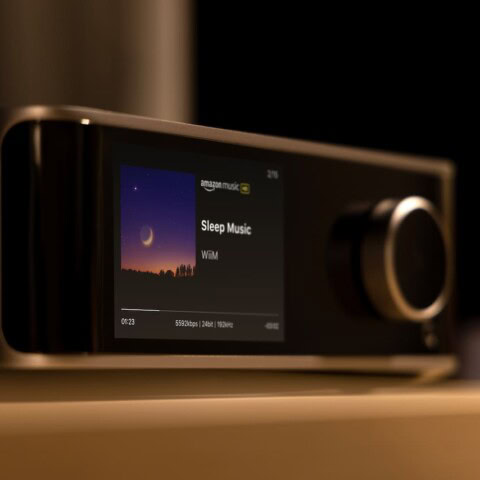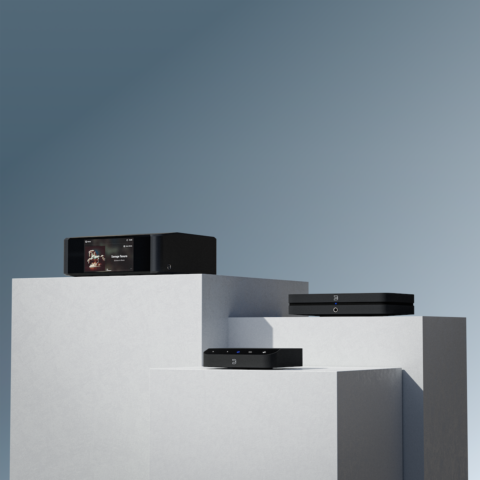Witchdoctor Rating
-
Total score - 10/1010/10
Summary
Price: $239
Kramer searches for flaws but finds little to fault in Cambridge Audio’s new DAC that also happens to be a headphone amp, and for a small cost will resurrect the ‘hi’ in fi coming out of your PC or Mac.
REVIEWERS LIKE EASY reviews and this is one of the easiest I’ve ever written. When it comes to Cambridge Audio’s little DACMagic XS, the basics are as simple as this:
1. Listen to tracks from a CD on my MacBook Pro via the standard 3.5mm jack using a set of Sennheiser’s excellent Momentum headphones (review here).
2. Then plug the DACMagic XS into the USB slot and listen to the same tracks on the same ‘phones.
3. Notice a definite improvement in the overall sound quality, contemplate the quality construction, flawless usability, not to mention the very reasonable price.
4. Repeat the above steps a number of times with different tracks and file formats before awarding the product an excellent rating.
5. Head for the beach.
If only it were that simple. Since 2007, the eagle eye and stern emails of Editor Steel have been keeping me from my relaxation. You don’t have to read the rest of the review because the above points are more or less all you need to know, but for the detail orientated readers out there (and Mr. Steel), here’s the rest.
Technically speaking, the DACMagic XS is a high quality, asynchronous 24-bit DAC (Digital to Analogue Converter) using an ESS9023 chip. It’s fully 24/192 capable via USB 2.0 (native on Mac but PC users will need to download some drivers). Of course, it’s also a headphone amplifier, although there’s nothing stopping users from plugging it into a hi-fi system using a 3.5mm to RCA cable.
At 30 x 10 x 54 mm (W x H x D) and a mere 100 grams, it’s a tiny little thing, which is good considering its intended purpose. There are but two buttons, which control the volume levels. Construction and build quality are good, and the DACMagic XS’s brushed aluminium case feels rugged enough to be bundled in and out of laptop bags indefinitely.
It’s shipped with a cloth drawstring bag and a short cable, with full size USB jack on one end to fit your computer and a Micro USB jack on the other end to go into the unit itself. Some will wonder why the DACMagic XS isn’t flash drive sized, and why it needs a cable. Some competing units such as Audioquest’s DragonFly are just USB sticks but I actually prefer the DACMagic XS’s form factor because there’s no way to break it off with an unfortunate swipe of a hand, or while moving the computer (unlikely, I know). However, the cable’s USB jack also takes up minimal room, and on computers with the USB ports placed close together, this makes a big difference.
A single 3.5mm output is located on the other side of the USB socket, along with a single indicator light that glows blue to indicate 44/48, green for 88/96 and purple for 176/192kHz. The LED also indicates min/max volume.
From the headamp perspective, the DACMagic XS offers more power than many (if not all) 3.5mm sockets on computer soundcards, along with its own high-quality 53-step analogue volume control that takes the soundcard and volume controls on the computer right out of the equation.
With the USB DAC section bypassing the rest of the soundcard, the music is effectively being handled by totally separate hardware, with the DACMagic XS even dealing with the clocking of the USB data. Given that the audio hardware components in most computers are from the cheapest of the cheap parts bins, all of this has to be a good thing.
Setting up the DACMagic XS really is as simple as plug and play. So it took less than a minute to unbox it and get some music playing. Listening to ‘Wish You Were Here’ from the Echoes, The Best of Pink Floyd double CD showed that the sound from the Mac’s 3.5mm output wasn’t too bad via the Momentum headphones. You could listen to this all day and be happy. However, when I listened with a critical ear, it was plain that the bass was a touch loose and that the treble, while quite detailed, had something of a tinny quality that definitely wasn’t coming from the ‘phones.
With the DACMagic XS in between the Mac and the Sennheisers, the treble became noticeably sweeter, with the strummed guitars sounding more natural than they did before. There was also definitely more authority to the bass; it was tighter but there was more of a sensation that the drivers in the ‘phones were being controlled with extra precision.
‘The Great Gig In The Sky’ from the first disc of Echoes CD was easier to listen to via the DACMagic XS, particularly at higher volume levels. Direct from the Mac, the vocals were just too harsh, so the DACMagic XS is adding a touch of smoothness without removing anything else. In fact, there’s no single aspect that isn’t improved by the addition of this little device.
I found this to be true whether I was listening to low quality Pandora streams, 320Kbps MP3s, CDs or even high res files. The most obvious improvements were heard on better quality files, with the 24/96 and 24/192 files benefiting most, especially at the top end, and in terms of ultimate detail and atmospherics.
Not all computers are created equal, and reasoning that nearly $3K of Mac probably has slightly better sound hardware than a $399 Acer Netbook, I tried the DACMagic XS on the cheaper computer. The sound from the Acer’s 3.5mm port was better than expected but not as good as the Mac – the bass in particular was woolly and ill-defined, while mids and treble were dry and somewhat harsh. No worse than most smartphones of course, but I was really listening for the flaws. The DACMagic XS solved these problems and offered the same all-round improvements that I’d heard on the Mac, basically an altogether more musical and enjoyable time in front of a computer. Installation was also effortless despite the general vagaries of the PC experience.
Conclusion
The DACMagic XS was even pressed into service between the Mac and my headphone rig (Perreaux SXH2 headamp with Nordost Shiva power cable, Slinkylinks cryo treated silver RCA interconnects and Sennheiser HD650 ‘phones) where it distinguished itself, sounding pretty damn fine; certainly a long way ahead of the 3.5mm jack on the Mac. That’s no shock but what did surprise was just how well the little Cambridge Audio box performed as a source in a reasonably revealing system.
The only limitation is the need to control volume from the unit’s volume buttons rather than keyboard shortcuts or dedicated volume keys but this is so minor an issue as to be barely worth mentioning.
So for $239, you get a well-designed product that’s more versatile than it looks. It’s easy to pack around, durable and sounds excellent. In short, it makes for a better computer audio experience, and considering how much time I spend in front of this Mac with a set of ‘phones in or on my ears, that’s a big win. Another winner from Cambridge Audio then, you’ll need a good set of ‘phones to take full advantage of its talents but everyone should own a decent set. I think I’ll just hang onto the review unit, it’s that good. ASHLEY KRAMER
www.pqimports.co.nz


















How does it compare to the Audioquest Dragonfly?
Nice review. But you didn’t mention that there needs to be some changes on the Mac’s audio settings in order to play hi-res files to their full resolution, as mentioned in this article from Macworld. Or perhaps USB bypasses this requirement…
http://www.macworld.com/article/1160651/how_to_find_and_play_high_resolution_audio_on_the_mac.html
$239! In a year a chinese copy will be doing the same job for less than $100. Just look at Fiio headphone amps.
@pete – You can say that about any product on the market because anything can be produced by some cheap Chinese brands. I’ve read reviews and compared products before buying, and the Fiio models are not as good as the Dragonfly and DacMagic XS. I finally decided to buy the DacMagic and I’m very happy with. It’s really small, well-built with a metal casing, and sounds excellent with my AKG headphones. You can’t go wrong with this one.